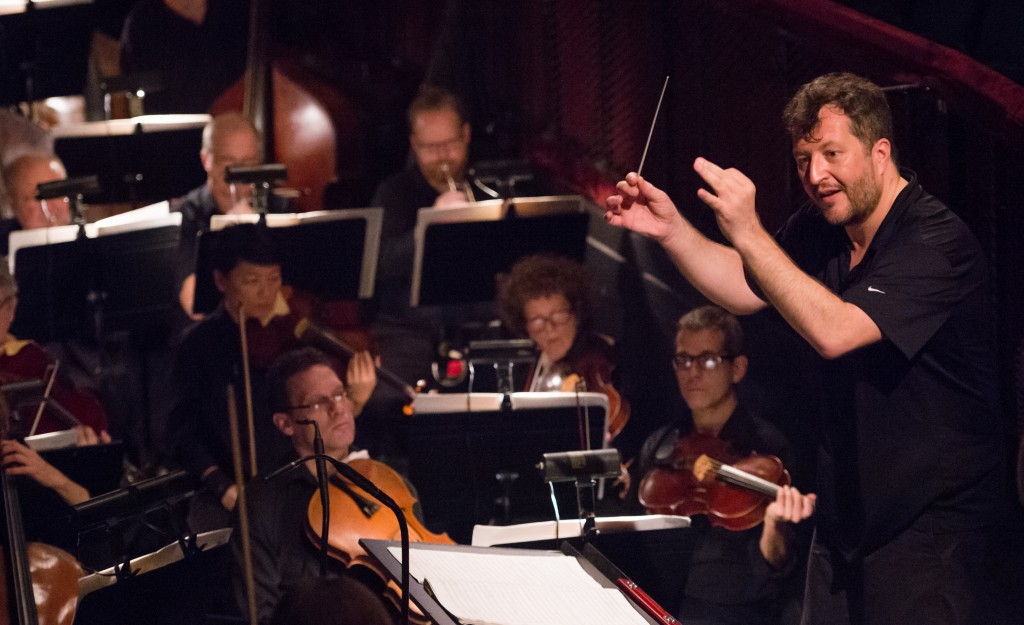Adès program merges dance and music with mixed success

Thomas Adès conducted the Orchestra of St. Lukes Saturday night at the White Light Festival. Photo: Kevin Yatrola
A quartet of dance pieces set to pre-existing music by a composer who doesn’t really write for choreographers, “Concentric Paths — Movements in Music” had its U.S. premiere over the weekend in New York and, in its ambitious reach, demonstrated the rewards and the limits of the impulse to be “interdisciplinary.”
“Concentric Paths” was the finale of Lincoln Center’s annual White Light Festival, a deep dive into the collaborative arts, wherein curators look for intersections among various forms and eras, and offer novel pairings as new possibilities.
The sixth annual White Light Festival was an eclectic wonderland stretching from Handel to Coltrane to the contemporary British composer Thomas Adès, whose works inspired the four dance pieces comprising “Concentric Paths.”
Adès himself was on hand to conduct and play piano, and his enthusiastic participation on Saturday night, in the second of three performances at the New York City Center, was a key to the program’s overall success.
Celebrated as a composer first and foremost, Adès, the visiting conductor, led the Orchestra of St. Luke’s confidently in the evening’s two big works, and he played superb piano in two smaller-scale pieces. He is not out of place in a choreographic setting, with his music combining pattern and disruption in ways that make sense for modern dance.
The only question is how fully “Concentric Paths,” which debuted in 2014 at Sadler’s Well Theatre in London, capitalizes on that insight.
The most spectacular and eye-grabbing of the four dances was the finale, “Polaris,” by choreographer Crystal Pite, named for the accompanying 2014 symphony by Adès.
But it was the opening set piece, “Outlier,” which choreographer Wayne McGregor based on a 2005 violin concerto — the titular “Concentric Paths” — that made the most of the music’s physical and visual potential, and created the strongest air of mystery and beauty. The cast of nine danced as if on a single string — a wavy and persistent line generated by violinist Thomas Gould. That powerful connection between Gould and the dancers held through three movements of varied orchestral and emotional terrain.
“Life Story,” set to a 1999 chamber arrangement of the same name, was more labored. With piano by Adès, vocals by soprano Anna Dennis, and words by Tennessee Williams, this energetically danced battle of the sexes played like a bar fight with accompaniment. The brisk, witty choreography for two by Karole Armitage; the stark, dissonant music; and the mordant Williams poem about doomed lovers were interesting in isolation but did not mesh as well as the other pairings.
A better fit was Adès’ 2000 Piano Quintet with “The Grit in the Oyster,” three bodies in movement designed by choreographer Alexander Whitley. The dancers, the Calder Quartet string ensemble and Adès at the piano shared tight quarters on stage, giving their interactions an appealing and informal air, even as the music and choreography were highly exacting.
Adès’ sonata-plus, at about 20 minutes, seemed to run a shade longer than Whitley’s capacity to interact with it meaningfully. The dancing in the final bars felt like running out of the clock. But for the greater part, this was a lean and spirited interpretation of music that paid inventive homage to forbears going back decades (Stravinsky) and centuries (Beethoven).
The closer, “Polaris,” was the evening’s designated breath-taker and tour-de-force. The music, with Adès conducting, built line on line, measure on measure, to a moment of cosmic revelation. The staging was exuberant and jaw-dropping, technically, although sometimes more literal than divine.
Beneath a bleeding black hole sun projected on the rear screen — a kind of negative North Star — dozens of dancers in black camouflage sprinted, formed vertices, and swayed like starlings in a murmuration. Choreographer Crystal Pike seemed to be calling down spectacle — everything from Busby Berkeley to hip-hop music video to the opening ceremony of the Beijing Olympics.
But “Polaris” also drew strength from contrast, and some of its most affecting passages were minimalist: dancers moving in almost complete darkness and silence, with only their outlines and the rustle of their movement to mark them; or two dancers alone together, with Adès unearthly legato score as their guide.






